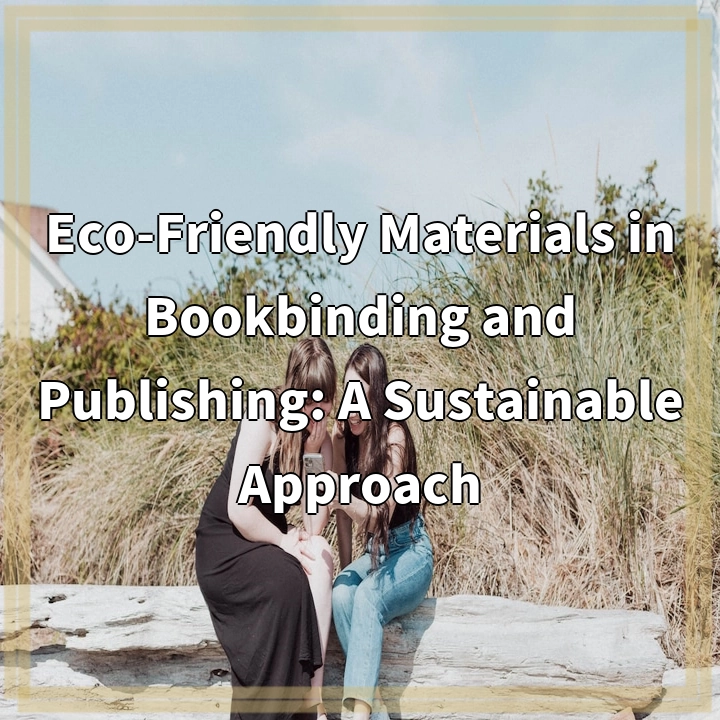
What is Eco-Friendly Materials in Bookbinding and Publishing?
Eco-Friendly Materials in Bookbinding and Publishing refers to the use of sustainable and environmentally responsible materials and practices in the production and distribution of books. It involves adopting alternatives to traditional bookbinding and publishing materials that have a lower impact on the environment.
Real-World Problems Associated with Eco-Friendly Materials in Bookbinding and Publishing
While the adoption of eco-friendly materials in bookbinding and publishing is a step in the right direction, there are some challenges that need to be addressed:
1. Limited Availability and Higher Costs
Eco-friendly materials often have limited availability in the market compared to traditional materials. This can result in higher costs for publishers and bookbinders, making it challenging for them to switch to sustainable alternatives. Higher costs can trickle down to consumers, potentially affecting the affordability and accessibility of eco-friendly books.
2. Quality and Durability Concerns
Some eco-friendly materials may have different characteristics compared to traditional materials. For example, recycled paper may not be as sturdy as virgin paper, affecting the durability of books. Finding sustainable materials that meet quality standards without compromising the integrity of the book is a continuous challenge for bookbinders and publishers.
3. Limited Customization Options
Eco-friendly materials may have limitations when it comes to customization options. For instance, certain natural dyes may not offer a wide range of color choices, limiting the design possibilities for book covers. Balancing sustainability and aesthetic appeal can be a challenge in the bookbinding and publishing industry.
4. Education and Awareness
One of the real-world challenges is the lack of awareness among consumers about the environmental impact of the publication industry. Educating readers and fostering a demand for eco-friendly books can be a slow process. It requires collaborative efforts from publishers, authors, and bookstores to promote the importance of sustainability in book production.
5. Recycling and Waste Management
Although eco-friendly materials are designed to be recyclable or biodegradable, proper recycling and waste management systems need to be in place to ensure their environmental benefits are realized. Implementing effective recycling and waste management practices within the bookbinding and publishing industry can be a logistical challenge that requires collaboration among different stakeholders.
In conclusion, while eco-friendly materials in bookbinding and publishing offer a sustainable approach, there are real-world challenges associated with their adoption. Finding solutions to these problems will require the combined efforts of publishers, bookbinders, consumers, and other industry stakeholders to create a more sustainable future for the publication industry.

Solutions to the Challenges of Eco-Friendly Materials in Bookbinding and Publishing
1. Increased Availability and Affordability
Efforts should be made to expand the availability of eco-friendly materials in the market. This can be achieved by promoting sustainable materials to suppliers and manufacturers, encouraging investment in sustainable production processes, and fostering partnerships between material suppliers and bookbinders/publishers. Additionally, exploring innovative and cost-effective alternatives to traditional materials can help reduce the cost barrier.
2. Research and Development for Improved Quality
Dedicated research and development efforts can focus on improving the quality and durability of eco-friendly materials. This involves finding innovative solutions, such as incorporating natural additives to enhance strength and durability, without compromising environmental benefits. Collaboration between material scientists, bookbinders, and publishers can drive advancements in sustainable material technology.
3. Diversity in Customization Options
Ongoing research can explore and expand the range of customization options for eco-friendly materials. This includes developing new natural dyes and pigments, exploring sustainable alternatives for special finishes, and adopting environmentally friendly printing and binding techniques. Educational campaigns can highlight the unique aesthetic benefits of eco-friendly customization options, encouraging their adoption.
4. Raising Awareness and Education
Efforts should be made to educate consumers, authors, and industry professionals about the environmental benefits of eco-friendly materials in bookbinding and publishing. This can be done through awareness campaigns, sustainability certifications for books, and collaborations with educational institutions. Increasing demand for sustainable books will encourage publishers to prioritize eco-friendly practices and materials.
5. Collaborative Recycling and Waste Management
Stakeholders within the bookbinding and publishing industry should work together to establish efficient recycling and waste management systems. This involves partnering with recycling facilities, implementing effective collection and sorting practices, and incorporating recycled materials back into the production cycle. Collaboration between publishers, bookstores, and consumers is essential to ensure that sustainable materials are properly recycled and disposed of.
By implementing these solutions, the bookbinding and publishing industry can overcome the challenges of eco-friendly materials and further embrace sustainable practices. This collaboration and commitment to sustainability will contribute to a greener and more environmentally responsible publication industry.















